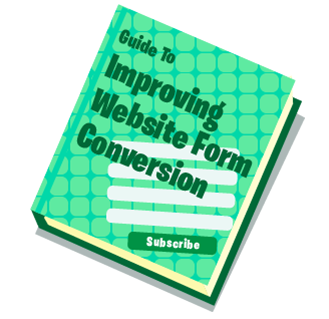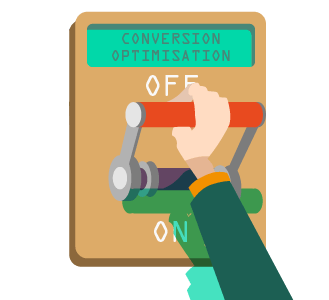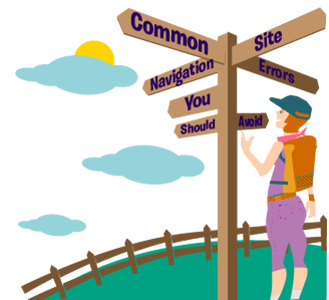Forms are the only way to collect user information on a massive scale.
With this information, you can use it to do all sorts of wonderful things for your business.
In business and marketing, information is king.
Improving your product, address complaints, gain insight into your market’s psyche, nurture leads, the list is endless.
People like proper forms that collect information that can help improve our user experience, and they hate bad ones that are confusing or intrusive.
Therefore, it is crucial that your online forms are appropriately optimised so you can gather as much information as possible.
Here are some tips to help you do things right and get the highest conversion rate possible.
Experiment with placing your form above or below the fold
The term “fold” came from the old world newspaper industry. Newspapers come with a horizontal fold across the middle of the page.
“Above the fold” literally means placing ads or stories right on top of the front page, before the middle fold on the newspaper. This is the area where people look at immediately when they walk past newsstands.
The stories a newspaper company puts above the fold can make or break their sales and profit.
Today, “above the fold” refers to the area on the webpage that visitors see the moment they land on your homepage, without having to scroll.
In general, having your form above the fold usually increases the number of signups.
But some businesses tend not to see the increase. For example, for insurance businesses, placing a form above the fold will be premature.
The visitor hasn’t had the chance to hear an explanation about what the company does first, or go through the site to understand the business.
Also, various studies show that a vast majority of web users scroll on a given page and that a significant percentage of visitors begin scrolling on the page even before the page has finished loading.
That means visitors are just as likely to see your form at the bottom of your page, as it is at the top.
So to know which location works best for your website, test out both.
Place one on the top of the page, and one at the bottom. You can also choose to put an anchor link and a CTA (call-to-action) button above the fold, which scrolls right to the bottom form when the user clicks on it.
Tweak your form headline into a strong CTA
Sometimes, a strong headline is what you need to push users over the edge and fill up their particulars.
Encourage your users to take the final step and complete that form by including a call-to-action directly above the form.
Your CTA should not only be strong, but catchy as well. It should leave a memory in the user’s mind even when they’ve exited the landing page.
The wording also affects the conversion rate too. For example, visitors are more compelled to click on “Get Started for Free,” than to “Create my Account.”
Make forms easy to answer
In an ordinary conversation, if someone asks a question and you don’t understand, you can immediately ask him to repeat or clarify his question.
On the internet, there is no way to do that. Your form is a sort of conversation between the users and your business, so you need to make sure that they’ve heard your question right the first time.
It should be evident that unfamiliar words or concepts are harder to understand for the general public.
The challenge is that what is usual within your industry may be unusual from the point of view of the person filling in the form.
Another common mistake is sometimes the way the question is phrased can be confusing to the user.
As an example, suppose that you need to find out whether customers with an email address are willing to be contacted by email.
It’s tempting to write this question: “If you have an email address, may we use it to contact you? Yes No”.
The problem is that users have to unwrap this single question into its separate parts to be able to answer, and then there are more possibilities than answers:
I have an email address; you can use it. (Yes)
I have an email address; you cannot use it. (No)
I don’t have an email address. (Yes or no?)
You need to be aware of such double questions and avoid using them in your forms.
Keep the length just right
The go-to advice on form length usually goes like this: “Keep your form short to get more conversions!”
This is only sometimes true. While it’s true that if your form is too long, people will be turned off for taking the time to fill it out, a shorter form might decrease the usefulness of the acquired information.
This could be bad for the sales team if they are getting too many low-quality leads to sift through.
The length of your form will depend on a couple things:
The offer’s stage in your buying cycle – For example, if you’re giving away a free checklist or infographic, you might only want to collect first name, last name, and email.
But if you’re giving away something more substantial like an ebook or whitepaper, indicating that people are further along the research process, you might want to ask for more detailed information, such as company address and number of employees.
How many leads you generate – If your sales team has too many leads to sift through every one, add more fields to your forms so your reps can better qualify each lead, and know which ones are worth calling.
If you’re still unsure how long your form should be, see which information is must-know vs. good-to-know.
For example, email addresses are almost universally essential to convert leads, whereas the age group of the user might not be that useful for your organisation.
You can make non-important items optional by denoting them with an asterisk (*).
Explain why you want to know the answer
Privacy trust issues occur when users have the answer but don’t want to reveal it to you.
By being transparent about what you are using their information for, you can address this issue and make users trust you more.
If prospects don’t trust you, they won’t convert. You need to convince them to give you their personal information through a sign-up form because while to them it may be a small step, to your business it’s a big one.
You can build this trust by giving them an explanation. But your answer must be truthful, believable and most importantly, the user must want to achieve whatever you’re using as your justification.
Place a simple privacy statement below your form to assure users that you will not abuse their information.
Privacy policies are essential for legal reasons.
It also helps you to be transparent as you connect with site visitors and build trust with them.
Even if your business doesn’t collect any sensitive information from customers, it is highly recommended that you have a privacy statement and operate your business by it.
Making the form flow easily
Your form should have a natural flow, like a well structured short story or a good sales copy. Ideally, it should be brief and to-the-point.
But what if you have more than a dozen questions to ask your visitor? You break up the form into parts.
This can be done by splitting the form across 2 or more pages, categorised according to topics.
For example, if you are doing a feedback survey form, the first page could be the user’s personal information, and the second page could be his opinions about your product or service.
If a single topic is too big for one page, it’s OK to split it across separate pages. But don’t split the topic flow by interjecting anything else in between.
Another way to keep the form flowing smoothly is to ask anticipated questions instead of springing unexpected ones on your users.
For example, the user fills in an opt-in form “contact us… for a free demo.” It would seem reasonable to expect that the next page will be about contact details.
Instead, the next question is “How did you first learn about…” the product. This question feels like a change of topic; it’s off-putting and shows a lack of attention to detail.
Ideally, we want to start our form with “easy” questions—the ones that don’t require much brain work to answer. That’s fine if they fit in with the conversational flow of the form.
But it’s not okay if the question is unexpected, especially if the relationship hasn’t developed far enough for the question to become acceptable.
Use progress indicators
A progress indicator is a graphic that shows the steps in the form and where you are along those steps.
It can be coloured dots or a bar that shows you where you are in the entire form process. It also makes sure that the user doesn’t skip any part of the form by accident.
A good progress indicator:
is honest, showing all the steps that you will go through;
is updated as the user works through the form;
uses a name or number or both (in addition to any images);
is consistently named or numbered;
is in the same place on each page of the form, preferably immediately above the questions.
Make your form stand out
To maximise completion rates of your form you need to provide a good user experience, to encourage sign-ups.
If you want to set yourself apart from your competitors you need to make your form stand out. A plain, generic form can be boring and detached.
However, a quirky, unique design communicates personality and friendliness, helping to make the submission process more enjoyable.
Use white space to allowing it breathing room to stand out from the rest of the information on your page.
Adding a splash of colour can generate an emotional response and aid in easily distinguishing between input fields.
Directional cues can help guide a visitor’s attention in a more literal way using triangulation to create focal points.
For example, icons are easy to understand and demand attention. They may not be subtle, but they work.
Using colour to highlight required fields is a non-intrusive way to ensure the user doesn’t miss an important field.
Your form should be easy to scan, with each element visually distinct. A well-designed form should have appropriately aligned fields, with the button size matching those of the areas.
You don’t have to be a designer to put together a stunning and attention-grabbing signup form. The key is to be creative, and to some extent follow techniques you know work.
Reward those that fill up your forms
Savvy internet users value their personal information and privacy and are unlikely to forfeit it for free.
Hence, if you ask for little, but give the user as much as possible, your conversion rate will be high because you give them something tangible and useful.
By explaining why users need to fill out a form and specifying the benefits in a clear and concise way, you motivate them to take action.
To entice users to fill out your form, offer a worthy incentive (often called ‘lead magnets’), such as discounts code, a free trial or consultation.
If you’re offering a newsletter, eBook or report, increase their appeal and highlight the value of the content, so users know what they’re going to get.
You should make it explicitly clear at the very top of your form what you’re offering in return for their contact information, but save the reward for after it’s submitted.
Using contact tools such as Aweber or GetResponse means you can automate the entire process, including the reward in your confirmation message and follow-up response.
As it’s impossible to guess which incentive will perform best, this is a great time to measure your conversion rate to determine how effective each reward is at getting visitors to fill in their details.
If you want to create great forms that convert, test them early and often
In the end, building highly optimised forms is all about what users tell you.
What sort of behaviour are they exhibiting when filling out those forms? What are the mistakes they are making? How they helped improve the form filling process.
All these user patterns and behaviour will help you learn learned what really works and what doesn’t.
So make sure you test them out with different variations, positions, and lengths. And test them as often as you can.







